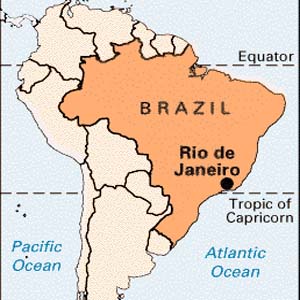Alternative Rio de Janeiro: a trip through the city's hinterland
 Rio de Janeiro - Thanks to the Copacabana, carnival and Sugarloaf Mountain, Rio de Janeiro attracts millions of holidaymakers every year.
Rio de Janeiro - Thanks to the Copacabana, carnival and Sugarloaf Mountain, Rio de Janeiro attracts millions of holidaymakers every year.
But most of them hardly ever venture beyond the outskirts of the city even though the surrounding area has plenty of picturesque colonial towns, coffee plantations, islands, national parks and verdant jungle to offer.
Serra da Bocaina National Park is just a few hours by car to the south of Rio, but the atmosphere is similar to the Amazon with orchids and fern-bedecked trees lining the stone path that winds through the rainforest.
The air is humid and tropical and the path is covered with moss, making it advisable to carefully consider every step.
It is hard to imagine how smugglers made their way 250 years ago to the historic town of Parati on the Atlantic coast.
Even more difficult to understand is how thousands of slaves walked through the dense forest along that same path. Today, it is one of the most attractive routes in the park.
Luciano Freie suddenly draws to a halt. "Can you hear that? We're almost there," says the trekking guide. At first, the noise is swallowed up by the bellowing of lemurs who live high in the trees' crowns. Then, the dim sound of Veadeiros waterfalls can be heard.
The ground becomes moister and the roar of the water gets louder until the falls can be seen. The waterfalls are among the most beautiful in Brazil with the water falling 100 metres.
The next stage of the journey is 18 kilometres long. Along the way you see cross mountain streams, accompanied by the calls of parrots and toucans. But you can also marvel at apes, tapirs, sloths and giant anteaters in the park which lies between the states of Rio de Janeiro and Sao Paulo.
The Serra da Bocaina park stretches as far as Parati which lies on a fjord-like bay.
"Oh God, if there is a paradise on earth, then it would look like this place," said the Italian explorer Amerigo Vespucci after seeing the small fishing village of the indigenous Guaiana people. Today, the town is one of the best-preserved, colonial settlements in Brazil.
In the 16th century, Parati became a busy urban centre at the end of the Caminho do Ouro or Gold Trail. But as the goldmines ran out, Parati declined and not until the 1950s was its historic character rediscovered.
The UNESCO has placed Parati on its tentative list of World Heritage Sites and cars are banned from its cobblestone alleys. Its white-tiled houses are decorated with colourfully painted window frames and doors.
From the town's port, you can take a boat to one of the islands in the bay. Ilha Grande is the largest of the hundreds of islands south of Rio. The long beaches of Lopes Mendes are among the most beautiful in the world.
Many holidaymakers are also attracted to the small bays where pirates used to hide in the past. A rather more touristy spot can be found in the north of the state, the peninsula of Buzios.
With its nightclubs, restaurants and up-market boutiques it has been dubbed the St. Tropez of Brazil.
If you want to experience more Brazilian culture, you would be advised to travel inland. Close to the small town of Vassouras, you can visit the colonial coffee bean estates where the coffee is fit for a king.
Another royal theme can be found 65 kilometres from Rio de Janeiro in the town of Petropolis where the Brazilian imperial family lived in the summer months.
The royal palace was built in the 1840s and is open to the public. Thanks to the town's colonial-style architecture and French-Gothic cathedral, you would hardly know you are in South America.
Internet: www. braziltour. com. (dpa)